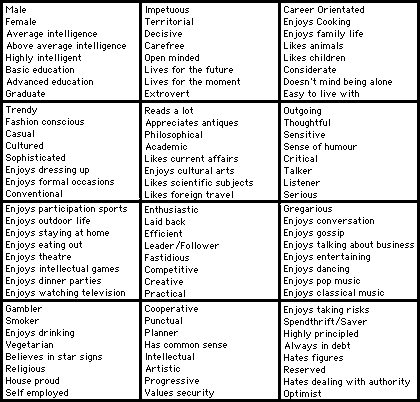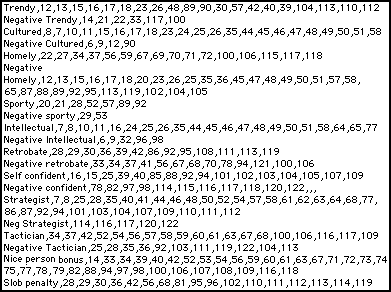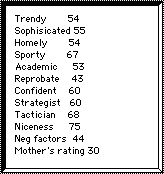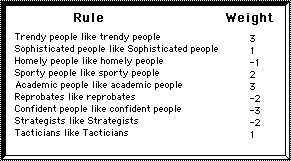

Creating a clone
About seven years ago I decided to test out these ideas in real life. I advertised in my local newspaper for people who were looking for partners to have bot clones made of themselves. These bots could then be arranged to mix with other bot clones to look for optimum partners.
To create the clones, I devised a questionnaire that allowed people to give various details about themselves. Besides the obvious physical and tangible characteristics, the questionnaire also carried many questions that might provide clues as to their attitudes and personality. This questionnaire is shown in figure 3.

Figure 3 - An example of the personality and attitude questions on the questionnaire. The responses to these questions are then turned into a binary string
The applicants were asked to tick the characteristics on this questionnaire they thought applied to them. From these responses, an array record could be created to correspond to the way people had answered the questionnaire. This record is shown in figure 4.

Figure 4 - An example of the record that is created from a questionnaire. Besides carrying information coded for physical and tangible characteristics, it carries a series of binaries to indicate how they had responded to the personality and attitude questions
Figure 4 is the computer record of a person called Kate McGibbon. It codes for her age and various physical qualities together with her answers to the questionnaire. It is effectively an electronic clone of this person, representing many of her physical characteristics, attitudes, tastes and preferences.
Creating a personality
It is unlikely that single questions would be reliable guides as to a person's overall personality and character, but, the average of a number of questions might be more significant. The questions were then arranged into groupings according to very broad categories. It was then very easy for a computer program to count the positive or negative responses to the questions in a particular category and give that category a score or rating. Figure 5 illustrates how the questions were grouped according to a number of categories.

Figure 5 - Some of the broad categories chosen to be representative of a person's character and personality, together with a list of questions that are taken into account for giving a score or rating in that particular category
Scoring each category for each clone record and expressing the results as percentages produces another record that describes the clone in a more general way. Such a record is shown in figure 6.

Figure 6 - A generalized clone personality, arrived at by grouping the answers from the questionnaire
Once you have a clone defined in this form, it is easy to make rules relating to the categories and give weightings to those rules. This is shown in figure 7

Figure 7 - Once you have categories, you can devise rules to relate those categories to attractions between different people. The relative importance of each category matching rule can be specified by giving each rule a weighting
With a whole batch of such rules and weightings a computer program can easily designate matches between various clones. This is in fact how this experiment was carried out seven years ago where all the clones met at a single party and were sorted into compatible groupings.
Limitations of a rule based system
The limitations of such a mechanical clone matching program are obvious. First is the choice of rules: are they the best rules to apply to any particular match?. The second problem is the accuracy of the weightings: what is the best weighting to apply in any particular matching operation? Clearly, a universal matching program, applied across the board to all clone match making, is subject to a large degree of inaccuracy. Each individual would probably be different, needing a unique set of custom rules and weightings applying specifically to them.
Here is where it is appropriate to give each clone a set of emotions. If every clone is provided with an emotion to correspond to each particular category, the resultant overall emotional response would be unique for any individual clone.
The catch is that these emotions (values put into the variables representing the emotions) have to be placed there by an emotional profile. Who is going to be able to calculate an emotional profile for every person in every category?
This is where John Holland's genetic algorithms can come into play because this is what they are ideal for: arriving at optimum values for a large number of variables in a complex system. Besides which, this is the exact same mechanism that has been responsible for the evolution of real emotions in every human on the planet.